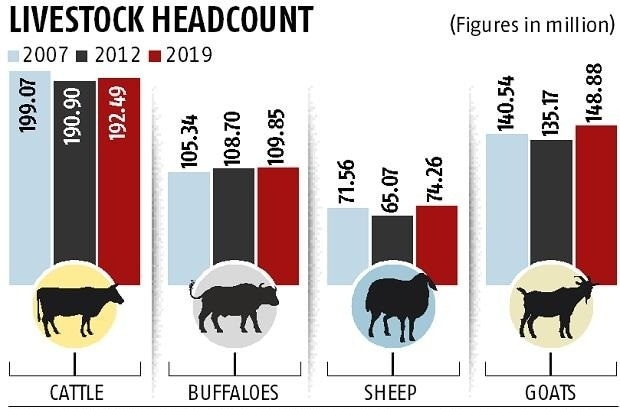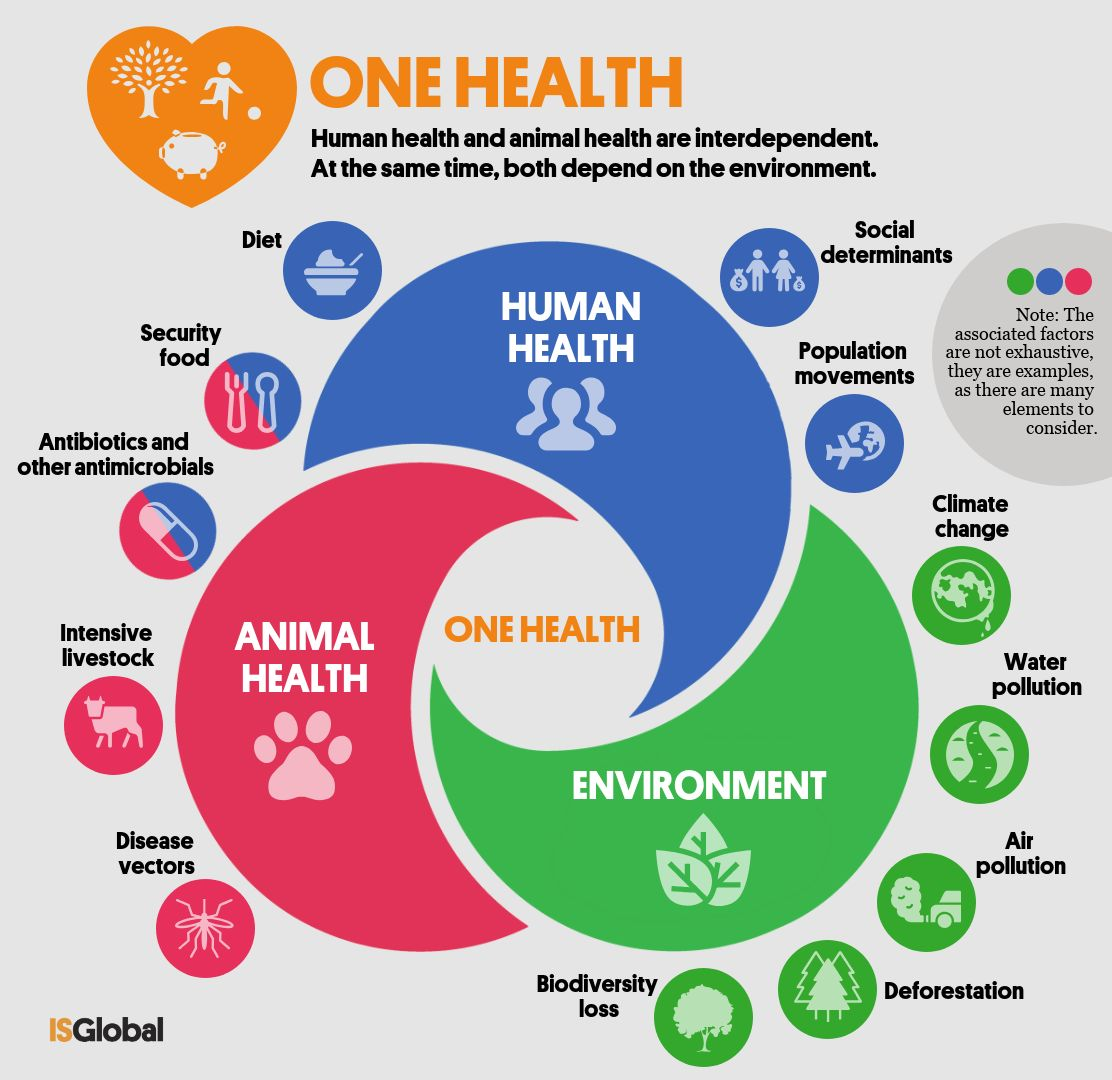Governance
India’s Livestock Sector
- 06 May 2025
- 12 min read
For Prelims: 20th Livestock Census, Nutritional Security, Lumpy Skin disease, Gross Value Added, Veterinary services, Genetic Surveillance.
For Mains: Significance & Contribution of Livestock in the Indian Economy, Current Challenges Related to Livestock in India, One Health Approach.
Why in News?
India’s livestock sector is a backbone of rural livelihoods and nutrition, making animal health a national priority. As World Veterinary Day 2025 celebrated the theme “Animal Health Takes a Team,” it underscored the critical role of veterinarians and the growing need for a One Health approach in tackling zoonotic risks.
What is the State of the Livestock Sector in India?
- Livestock: India has the world’s largest livestock population and it is a key pillar of Indian agriculture, supporting rural livelihoods, nutrition, and economic growth.
- It involves rearing cattle, buffaloes, sheep, goats, pigs, and poultry for meat, milk, eggs, and wool.
- Key Livestock Data:
- As per the 20th Livestock Census (2019), India has a total livestock population of 535.78 million.

- Milk, Meat, and Egg Production: India ranks 1st in milk production, contributing 24.76% of global production.
- India ranks 2nd in egg production (1st China) and 5th in meat production globally (Food and Agriculture Organization, 2022).
What is the Significance of the Livestock Sector in India?
- Contribution to GDP: The livestock sector grew at a CAGR of 12.99% (2014-15 to 2022-23), contributing 5.50% of India’s Gross Value Added (GVA) in 2022-23.
- It also provides employment to about 8.8 % of the population in India.
- Nutritional Security: Livestock ensures food security by providing protein-rich products like milk, eggs, and meat. The dairy sector alone accounts for two-thirds of the total value of livestock output.
- Sustainability and Climate Resilience: Livestock supports sustainable farming by providing organic manure, improving soil fertility, and reducing chemical use. Integrated livestock-crop systems enhance resilience, especially in drought-prone areas.
- Exports and Foreign Exchange: Exports of livestock products, including buffalo meat, dairy, and poultry, rose by over 10%, reaching USD 3.64 billion during April-December 2024, strengthening India’s foreign exchange.
- Poverty Alleviation: Livestock is a key asset for poverty reduction, with over 50% of rural women engaged in livestock activities, contributing to income and financial independence.
- Cultural and Societal Importance: Livestock has cultural and religious significance, especially in festivals and rituals. In states like Rajasthan and Gujarat, it also reinforces community bonds and preserves traditional practices.
What are the Key Issues Associated with the Livestock Sector in India?
- Low Productivity: India’s livestock productivity, especially in dairy, meat, and poultry, remains low compared to global standards.
- For example, India's average annual cattle milk productivity in 2019-20 was 1,777 kg/animal, well below the global average of 2,699 kg (FAO, 2019)
- Inadequate Infrastructure The sector suffers from poor breed quality, inadequate feeding, lack of proper veterinary services, cold chain facilities, and modern slaughterhouses.
- This leads to high post-harvest losses, poor product quality, and limited market access for small farmers.
- Climate Risks & Environmental Impact: Climate change affects livestock productivity due to erratic weather, rising temperatures, and feed shortages.
- On the other hand, livestock farming itself contributes to methane emissions and contributes to soil degradation and biodiversity loss due to overgrazing practices.
- Health Risks Zoonotic diseases like avian influenza, foot-and-mouth disease (FMD), and brucellosis pose significant health threats.
- Around 60% of infectious diseases are zoonotic, and 75% of emerging infections are of animal origin.
- Poor hygiene, inadequate veterinary services, and lack of awareness increases the spread of such diseases.
- As per the data indicated by the Secretary of the Department of Animal Husbandry and Dairying (DAHD), India needs to produce 2500 additional veterinary graduates annually for the next five years to meet the growing demand.
- Lack of Adequate R&D: Lack of R&D in livestock genetics, nutrition, and disease control hampers progress and greater focus is needed on breed improvement, efficient feed systems, and veterinary advancements to boost sector performance.
What are the Key Initiatives to Strengthen the Livestock Sector?
- National Initiatives:
- Livestock Health and Disease Control (LHDC) Programme
- National Animal Disease Control Programme (NADCP)
- National Livestock Mission (NLM)
- Animal Health Security Strengthening in India for Pandemic Preparedness & Response: It is backed by FAO, ADB, and World Bank to support India’s animal health security by upgrading labs, improving surveillance, and training field vets for pandemic preparedness.
- International Collaborations:
- Food and Agriculture Organization (FAO): FAO has strengthened India’s veterinary services by standardizing treatment guidelines (2024).
- It has supported AMR management through the National Action Plan 2.0 and the Indian Network for Fisheries and Animal Antimicrobial Resistance (INFAAR).
- FAO has also trained veterinarians via the In-Service Applied Veterinary Epidemiology Training (ISAVET).
- Asian Development Bank (ADB) and the World Bank: They support India in enhancing animal health security by funding infrastructure, improving zoonotic disease surveillance, upgrading labs, and strengthening veterinary training for better pandemic response.
- Food and Agriculture Organization (FAO): FAO has strengthened India’s veterinary services by standardizing treatment guidelines (2024).
What Measures can be Adopted to Enhance Productivity and Sustainability of India's Livestock Sector?
- Breed Improvement and Nutrition Enhancement : Promote genetic upgradation through selective breeding and artificial insemination.
- Improve fodder management, develop region-specific feed formulations, and enhance pasture management to boost productivity and reduce overgrazing.
- Strengthen Veterinary Services: Strengthen veterinary care access, vaccination, disease surveillance, and early warning systems, supported by agencies like FAO, ADB, and World Bank.
- Provide incentives to veterinary doctors to serve in rural and underserved areas.
- Strengthening R&D and Technology Adoption: There is a need to increase investment in R&D for livestock genetics, climate-resilient practices, and disease control, while promoting reproductive technologies and sustainable farming practices.
- Improving Infrastructure and Market Linkages: Improve cold chains, storage facilities, and processing units. Strengthen farmer-producer organisations (FPOs) for better market access and fair pricing.
- Adopt One Health Approach: Integrate human, animal, and environmental health through cross-sector collaboration, strengthening surveillance and response systems to tackle zoonotic diseases and antimicrobial resistance.
What is the “One Health” Approach?
- About: The One Health approach is a collaborative, multisectoral, and transdisciplinary strategy that recognizes the interconnectedness of human, animal, and environmental health.
- It promotes integrated policies and programs aimed at preventing global pandemics and improving public health outcomes.
- Key Features:
- Holistic Perspective: Focuses on the shared environment, human-animal interactions, and ecosystem balance.
- Disease Prevention: Aims to reduce the risk of zoonoses like rabies, Ebola, avian influenza, Covid-19, and antimicrobial resistance (AMR).
- Long-term Planning: Encourages preventive health strategies rather than reactive responses.
- Historical Context & Institutional Initiatives:
- The One Health approach began in 1947 with WHO’s veterinary public health unit, inspired by James Steele’s “one medicine” concept, and is reflected in declarations like Alma-Ata (1978), Ottawa Charter (1986), and Shanghai Declaration (2016).
- WHO leads through the One Health Initiative Team and the quadripartite collaboration (WHO, FAO, OIE, UNEP), supporting countries with policy integration and early disease detection.
- The National One Health Mission is a comprehensive initiative in India aimed at strengthening the country's disease response and promoting a holistic approach to public health
Conclusion
The livestock sector plays a crucial role in India’s economy, rural livelihoods, and food security. Strategic initiatives, such as breed improvement, enhanced veterinary services, and the adoption of a One Health approach, are key to fostering sustainability and improving overall sector performance.
|
Drishti Mains Question: Discuss recent trends in livestock production in India and assess the impact of government initiatives on the sector. |
UPSC Civil Services Examination, Previous Year Questions (PYQs)
Prelims
Q. As per the NSSO 70th Round “Situation Assessment Survey of Agricultural Households”, consider the following statements: (2018)
- Rajasthan has the highest percentage share of agricultural households among its rural households.
- Out of the total agricultural households in the country, a little over 60 percent belong to OBCs.
- In Kerala, a little over 60 percent of agricultural households reported to have received maximum income from sources other than agricultural activities.
Which of the statements given above is/are correct?
(a) 2 and 3 only
(b) 2 only
(c) 1 and 3 only
(d) 1, 2 and 3
Ans: (c)
Mains
Q. Livestock rearing has a big potential for providing non-farm employment and income in rural areas. Discuss suggesting suitable measures to promote this sector in India. (2015)







